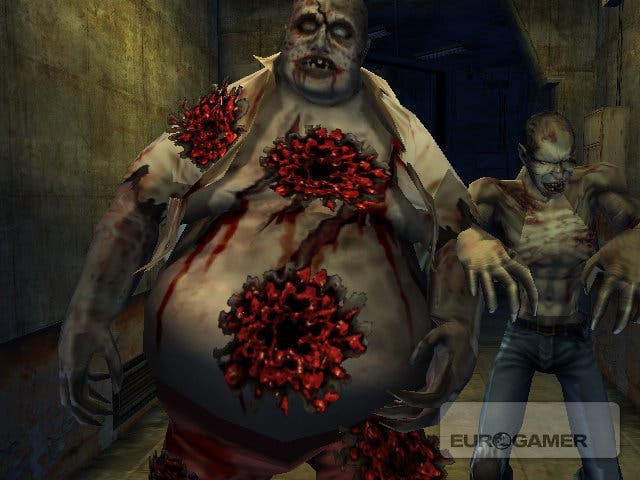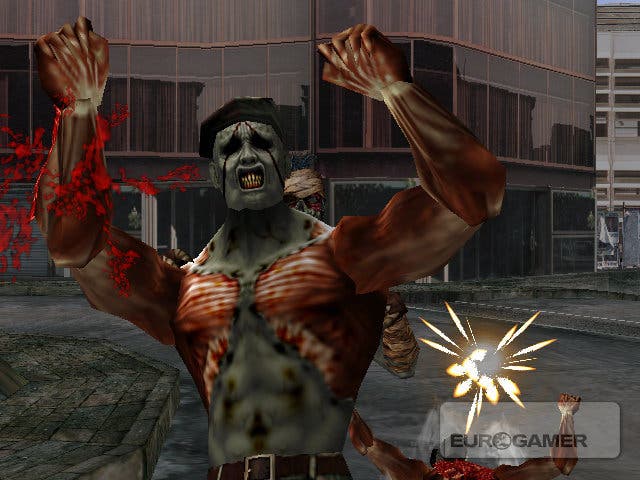The House of the Dead 2&3 Return
I don't wanna die!
You can either berate SEGA for blatantly cashing in on its tired old light-gun back catalogue, or continue to celebrate the fact that the Wii is the new spiritual home for all these old classics, with a control system that lends itself perfectly to the genre. It's little wonder we're currently experiencing a flood of old and new point-and-shoot blasters. Recently, SEGA got the ball rolling by belatedly treating us to a port of 2004 arcade title Ghost Squad, so it's only logical to service this peculiar niche by re-issuing something more renowned and familiar - in this case House of the Dead 2 and 3 in the same package. If you care enough about the genre, the chances are you'll already own one or the other (probably both), and will simply relish the chance to play them again using the Wii controllers - either the Wii Zapper or the similarly adept Wii Remote.
Don't come! Don't come!
Looking at HOTD 2 now is simultaneously heart-warming, hilarious and terrifying. One of the star releases in the early days of the ill-fated but much-loved Dreamcast, it came out in an era when routinely, unintentionally hilarious voice-acting was par for the course. Full of solid gold Japlish utterances and delivered with the kind of cold, stilted monotone that you only ever seem to hear in Western versions of Japanese videogames, it has a peculiar charm that's far greater than the sum of its parts. Hearing it again all these years later is a strangely wonderful thing, with age only helping to enhance its kitsch status.

Even the angular late '90s visuals of HOTD 2 have a strangely perverse appeal. Far enough advanced from the embarrassing 3D visuals of the early '90s and sharp, detailed and well-animated enough to still be bearable by today's standards, this NAOMI-powered title still manages to hold a stylised nostalgic appeal. Although SEGA managed to create a pretty decent 3D engine for the time, and create a posse of still-terrifying zombies, its hilarious attempts to render realistic-looking humans is almost as unhinged as its approach to voice-overs, with stilted animation and wonderfully deranged faces guaranteed to raise a smile. And even with its occasional technical aberrations taken into account, in terms of out-and-out style and in pure playability terms HOTD 2 beats the squishy-looking sequel hands down.
As an example of the genre, there are few on-rails shooters that can claim to be as hardcore as HOTD 2. With absolutely zero concessions to notions of accessibility, the only way to get through its five stages was supreme dedication, memorising every part of every stage, and deploying cat-like reflexes with an epileptic trigger finger to back them up. That the game could still prove to be a huge challenge when set to Very Easy difficulty gives you some idea of where SEGA was pitching it. But, obviously, as an arcade game, its job was to entertain while extracting coins to encourage the inevitable Continues.
Dogs of the AMS

Playing it almost a decade on, it's hard not to feel slightly aggrieved by the challenge, but within a few goes the blow is softened by earning more credits, more lives, and, of course, unlocking the Very Easy mode. You'll also start to remember the stages with more clarity, and be able to play it like the old days. The fact that it's still an awful lot of fun is a testament to how strong the game was in the first place, with tons of branching paths based on various gameplay conditions lending it an incredible amount of replay value. It's also good to note how well SEGA has retooled the controls for the Wii remote. If anything, the game feels better than it did with the Dreamcast light-gun, so if you're an aficionado, you'll be extremely pleased at how it's turned out. The only slight negative point is the original 4:3 image has now been stretched, but it's not something that will trouble you for long.
All the original modes are present and correct, along with little bonuses such as training videos, and a ten-stage training mode, which is, incredibly, even more hardcore than the main game itself. Seemingly simple tasks, such as clearing all the baddies with 30 bullets, or blasting all the barrels within a strict time limit are unbelievably tough, but the kind of tasks that keep you coming back. As with the previous home versions, you also get to choose between Arcade and Original mode - the latter a variation based around weapon enhancements which you get to apply prior to starting the game.








